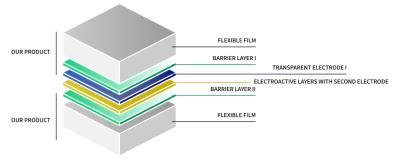This is a sponsored post by Ergis Group
In 2020, Poland-based Ergis Group launched the noDiffusion film platform, a high-barrier film that offers high level of optical transmittance and low level of light scattering, and the ability to contain transparent conductive electrodes. The new technologies adopted in the production of the barrier films offer a combination of high performance and competitive pricing.

Ergis has been busy since 2020, scaling up its production capabilities, and progressing towards production in a roll-to-roll configuration (rather than the batch system it used before). Ergis is using two different technologies - ALD and sputtering to deposit the barrier and the conductive electrodes.
ALD is a relatively new technology, which Ergis aims to use for the deposition of a high-performance barrier on top of the film. The company is facing some delays with the ALD equipment and performance, and has since developed the capability to use sputtering for the barrier deposition.
Sputtering is more mature, and the company managed to commercialize the technology quickly. It has managed to produce sample rolls of its noDiffusion film, manufactured using R2R technology with a light barrier film. The company reports performance of around 10-4 wtr performance for its barrier. This is referred to as a "light-barrier" as it is not suitable for high-end OLED display application, but could be used in other OLED applications that do not require ultra-long lifetimes. The company is shipping barrier film samples to its customers.
The next stage for Ergis is to finalize the ALD R&D effort and enable cost-competitive high-end (10-6) barrier films, suitable for standard OLED display applications. The company hopes to achieve samples of ALD barrier films by the first half of 2024.